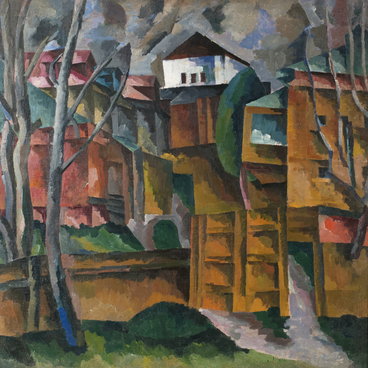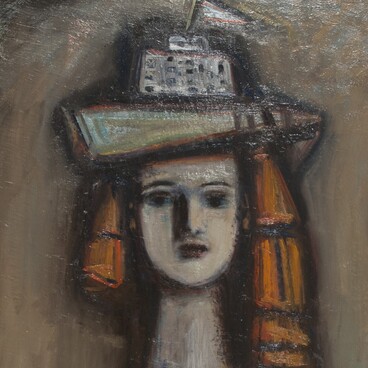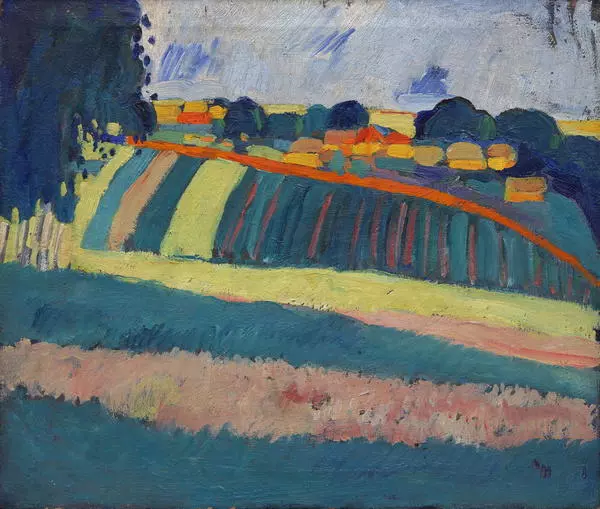In parallel with Moscow avant-garde associations, and virtually outpacing them, an association of innovative painters and graphic artists with a far-reaching creative program emerged in Saint Petersburg that had the same pretension that existed in the capital of uniting the heterogeneous pursuits of Russian left-wing artists into a single ‘Youth Union’. Iosif Shkolnik was perhaps the most active organizer, participant, and exhibitor at all his exhibitions. Unfortunately, his creative legacy has not been preserved in its entirety: a significant portion of it has been, in all likelihood, irretrievably lost. That made it all the more interesting that in Saratov in the 1960s a substantial group of his works from this particular period was discovered. These included two landscapes that were most likely painted in the Kryukovskoye Forest District (Tula Province). It was in this forest reserve, which produced the conditions for creative work, that Shkolnik willingly spent the entire summer. The works that he did there were included in his ‘Province’ series, which he showcased at the fifth ‘Youth Union’ exhibition (1913-1914).
Iosif Shkolnik at this time was not one of the most radical innovators, but his attachment to what is visible was complicated when he cast an eye on the achievements reached by the latest French painters. And not only by Van Gogh, who has one canvas with which Landscape with a Road (early 1910s) echoes thematically, but also the fauvists. It was not by chance that Alexandre Benois, spoke slightly ironically about the fact that Shkolnik allegedly claimed resemble a St. Petersburg version of Matisse. In fact, the increased brilliance in the Landscape with a Flowerbed (early 1910s) presented here, not to mention its picturesque graphics, may give rise to this kind of an association.
But as a born decorative artist, keen on work involving theatrical scenery, Iosif Shkolnik skillfully maintains those planar surfaces in his easel painting as well. Landscape with a Road was created in 1910, at the height of the author’s quests for modernism. This picture was painted in a provisional manner, and is built upon a combination of open, bright colors, primarily with planes of green and yellow. There is no perspective of light or air in the landscape, and the depth of space is generated by changing rhythms. The foreground is composed of wide, irregular, horizontal stripes of malachite and ocher color, followed by a dynamic chain of alternating vertical lines that keeps picking up momentum. In the background, the yellow-green spots become more compact, and the brushstrokes become more vigorous. With its sonorous coloring and provisional dimensionality, the picture resembles the drawing of some theatrical scenery, while the artist has not lost the connection with the specific motif. The artist focuses on the bright sunlight, cloudy skies, the quivering crowns of birches, and the image of a summer day appears in front of us. The warm, welcoming palette creates a buoyant mood, and the active rhythms give the whole work a cheerful, energetic feel.
Iosif Shkolnik at this time was not one of the most radical innovators, but his attachment to what is visible was complicated when he cast an eye on the achievements reached by the latest French painters. And not only by Van Gogh, who has one canvas with which Landscape with a Road (early 1910s) echoes thematically, but also the fauvists. It was not by chance that Alexandre Benois, spoke slightly ironically about the fact that Shkolnik allegedly claimed resemble a St. Petersburg version of Matisse. In fact, the increased brilliance in the Landscape with a Flowerbed (early 1910s) presented here, not to mention its picturesque graphics, may give rise to this kind of an association.
But as a born decorative artist, keen on work involving theatrical scenery, Iosif Shkolnik skillfully maintains those planar surfaces in his easel painting as well. Landscape with a Road was created in 1910, at the height of the author’s quests for modernism. This picture was painted in a provisional manner, and is built upon a combination of open, bright colors, primarily with planes of green and yellow. There is no perspective of light or air in the landscape, and the depth of space is generated by changing rhythms. The foreground is composed of wide, irregular, horizontal stripes of malachite and ocher color, followed by a dynamic chain of alternating vertical lines that keeps picking up momentum. In the background, the yellow-green spots become more compact, and the brushstrokes become more vigorous. With its sonorous coloring and provisional dimensionality, the picture resembles the drawing of some theatrical scenery, while the artist has not lost the connection with the specific motif. The artist focuses on the bright sunlight, cloudy skies, the quivering crowns of birches, and the image of a summer day appears in front of us. The warm, welcoming palette creates a buoyant mood, and the active rhythms give the whole work a cheerful, energetic feel.






